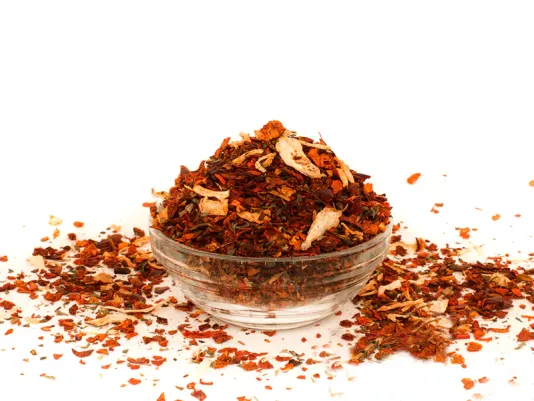Tarragon Pie (Kartli)
Tarragon pie (Kartli) - a recipe for Georgian cuisine, drinks, syrup are cooked from tarragon, it is eaten fresh with cheese and lavash

Kharcho-Suneli is a concentrated spice mix designed to highlight the depth of a meaty broth and tomato base. It usually includes ground coriander, fenugreek, red and black pepper, garlic, bay leaf, savory, and sometimes dried dill or a touch of saffron for color. I always choose a blend with moderate heat: true kharcho should be rich but not burning. From my experience, this spice performs best when added to warm liquid rather than boiling – that’s when its aroma fully unfolds. For soups or sauces, I add it after sautéing onions and tomatoes, when the mixture is warm but not boiling. Over the years, I’ve learned to sense the balance: too much spice makes the dish bitter, too little leaves it flat. I store kharcho-suneli only in a tightly sealed jar since its essential oils evaporate quickly. The right mix smells deep, without harsh bitterness – then the dish turns out expressive and refined.
Over years of cooking, I’ve learned to tell the real blend from simplified copies. I always pay attention to color: it should be warm, golden-brown with greenish specks of herbs. If the tone is dull or grayish – the spices are old. Aroma is the main indicator: a good kharcho-suneli has a complex, spicy-hot scent with subtle smokiness and no sour notes. I avoid overly fine grinding – spices lose their aroma faster, and the dish turns flat. I buy only from trusted sellers who mix small batches. At home, it’s best to store spices in a dry jar with a tight lid, away from heat and sunlight. If the aroma fades or an off-smell appears, I replace the blend without hesitation. True kharcho-suneli is powerful – even a pinch can flavor a large pot of soup. I always test freshness by rubbing a pinch between my fingers – if the skin stays aromatic, the spice is fresh.
From my experience, kharcho-suneli doesn’t like haste. Before using, I lightly warm the blend in a dry pan – no more than ten seconds over low heat. This awakens the essential oils and enhances the aroma. If overheated, the spices lose their natural sweetness and become bitter. I add them when the dish already has a base: sautéed onions, tomatoes, garlic, and part of the broth. At this stage, the spices combine with fats, creating a deep aromatic layer. If the soup cooks for a long time, it’s best to add kharcho-suneli in two stages: half early for flavor structure, and the rest near the end to refresh the aroma. For thick sauces, I dissolve the blend in a little warm broth and add it gradually. The key is to avoid boiling – otherwise the essential compounds evaporate. I always say kharcho-suneli blooms through warmth, not fire, and that difference determines how “alive” the final flavor will be.
When I cook with kharcho-suneli, I maintain a medium temperature so the spices don’t “burn”. For kharcho soup, that means gentle simmering, when the broth’s surface barely moves. Vigorous boiling destroys essential oils, and even the best blend loses character. When making sauces or gravies, I let them rest under a lid after removing from heat – this stabilizes the aroma. For baked dishes, I add the spices directly to the marinade, especially if it contains an acidic element – tomato, pomegranate juice, or wine: acidity helps the flavors penetrate meat more deeply. I’ve noticed that even serving temperature affects perception: hot dishes seem milder, while cooled ones reveal sharper notes. That’s why I always adjust the amount depending on whether the dish will be served right off the stove or slightly cooled. This attention to temperature preserves kharcho-suneli’s complex, warm aroma without bitterness.
Kharcho-suneli pairs perfectly with meat, especially beef and lamb. I often add it to sauces for chicken or turkey when I want a deeper flavor. The blend works wonderfully with tomatoes, garlic, and onions – the classic trio for kharcho soup. With vegetables, it should be used sparingly: it can dominate, so a pinch is enough to add character. In legume dishes, especially with beans, it adds pleasant warmth without excessive heat. I like to combine kharcho-suneli with a bit of cilantro or parsley at the end of cooking – it enriches the aroma. In creamy or sour cream sauces, it creates a light, elegant bitterness that complements roasted meat. When added to a marinade with garlic and lemon juice, the spices unfold their aroma without making the meat bitter. It’s all about balance: strong components should never overpower the main ingredient.
People most often make the mistake of adding kharcho-suneli too early or in excessive amounts. The blend has a strong personality, so even a small dose defines the dish’s flavor. If thrown into boiling broth, the aroma vanishes, leaving only bitterness. I always advise adding spices once the dish has slightly cooled or right before removing from heat. Another common mistake is mixing with fat at the start of frying – the spices overheat and darken quickly. It’s better to add them to the cooked base, where the temperature is lower. Yet another mistake is storing them in a humid place: spices clump, lose texture, and aroma. I keep kharcho-suneli in a glass jar, away from the stove, sealing it tightly after each use. For me, quality control is not only about smell but also how the mix behaves when heated: if the aroma turns flat or harsh, the spices are spent. I always choose freshness and moderation – that’s the key to a clean, deep flavor.